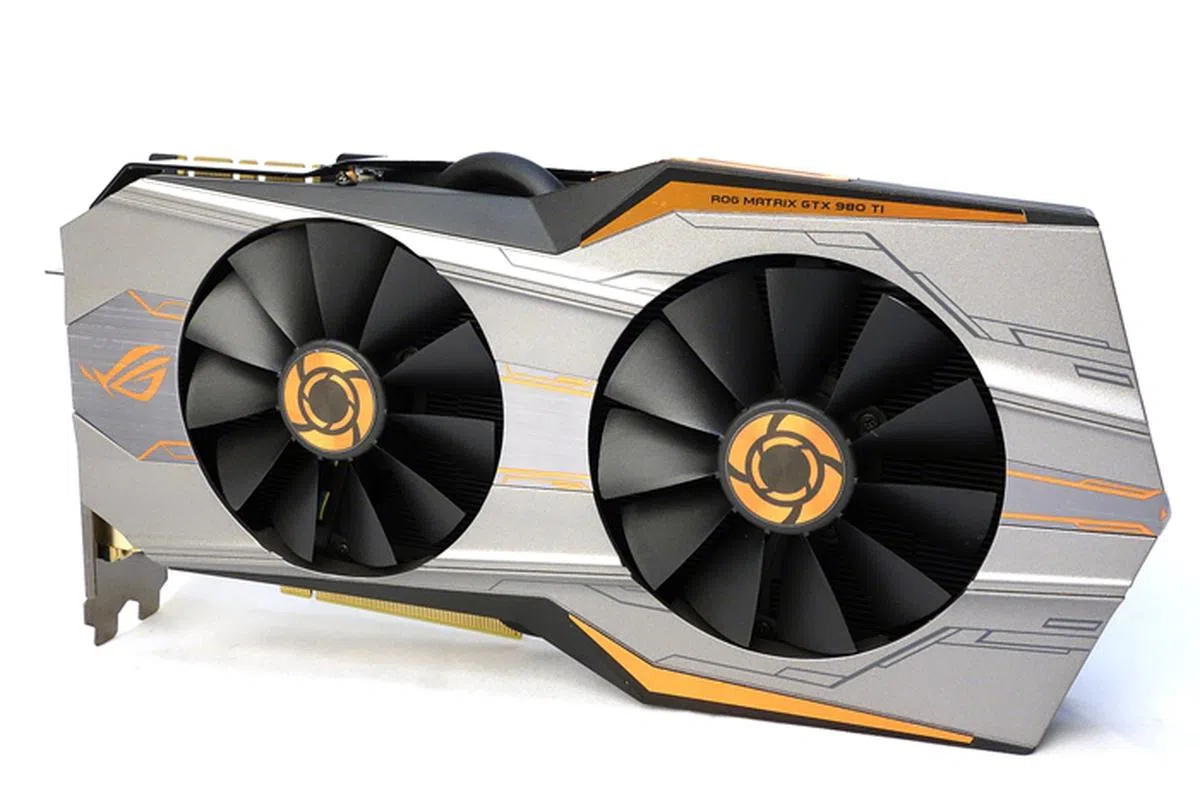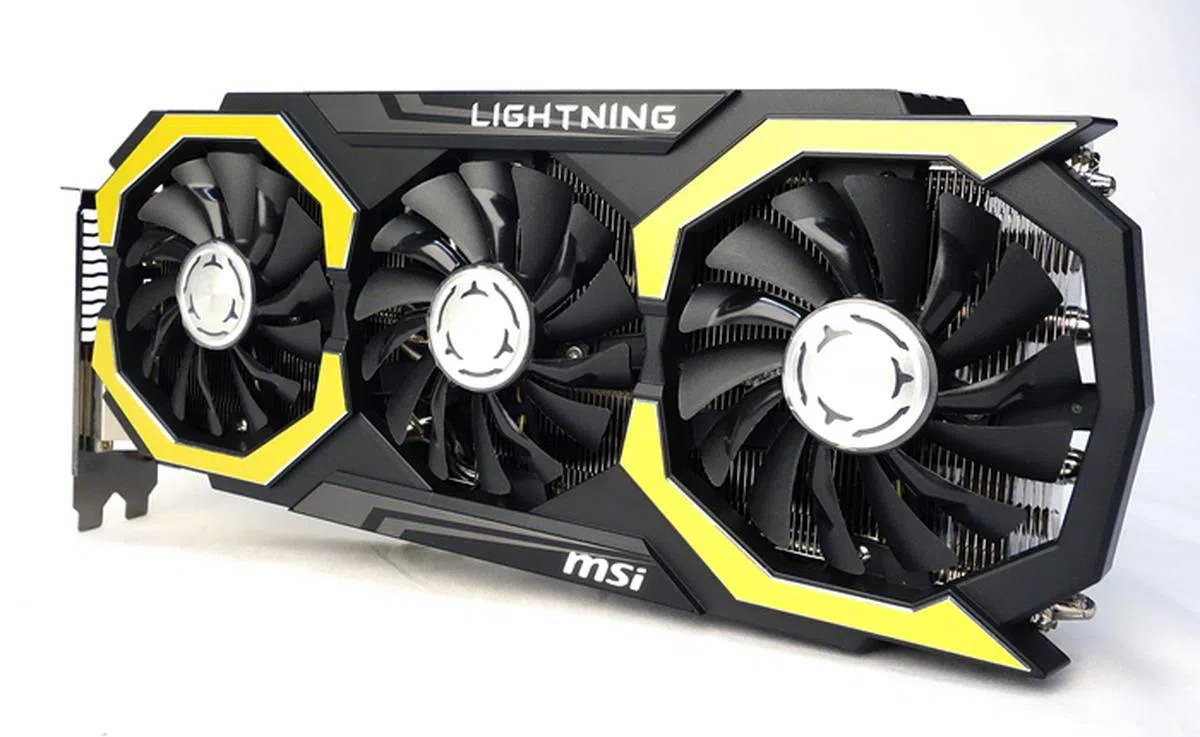Clash of the (Ti)tans: Another NVIDIA GeForce GTX 980 Ti custom card shootout
The NVIDIA GeForce GTX 980 Ti is, by far, the best single GPU graphics card for PC gaming at the highest settings possible. However, all good things must come to an end as the graphics chip will see its last days soon. Before its final curtain call, we put two extreme GTX 980 Ti cards from ASUS and MSI to their final test.
By Wong Chung Wee -
Clash of the (Ti)tans: Another NVIDIA GeForce GTX 980 Ti custom card shootout

(left) The ASUS ROG Matrix GTX 980 Ti Platinum Edition card; (right) the MSI GeForce GTX 980 Ti Lightning card. Take a good look at them as these high-end cards could be the last of their prestigious breed.
Since its launch in June 2015, the NVIDIA GeForce GTX 980 Ti graphics card has set the bar high in terms of gaming performance. We have seen NVIDIA's add-in card partners come up with variant cards that were mainly differentiated by their customized cooling solutions and their power delivery systems. It is almost a year since the debut of this powerhouse graphics card, and its offerings are drying up as NVIDIA card partners wisely shore up their efforts in preparation for the next generation NVIDIA Pascal graphics card. There are even rumors that NVIDIA has halted production of select Maxwell GPUs.
So rumors aside, let’s take a look at what could be the last NVIDIA GeForce GTX 980 Ti cards on the market, from ASUS and MSI respectively. For all you know, these could go for a nice price once the new Pascal GeForce cards debut in the next few weeks.
ASUS ROG Matrix GTX 980 Ti Platinum Edition

The ASUS ROG Matrix GTX 980 Ti Platinum Edition card is one of the most visually striking cards. Its orange on grey fan shroud grabbed our attention right out of the box.
The ASUS ROG Matrix GTX 980 Ti Platinum Edition card is one of the most visually striking cards on the market. Its orange-on-grey fan shroud grabbed our attention right out of the box. Good looks aside, the card feature 6GB of GDDR5 video memory, and its Digi+ VRM technology drives its 14-phase power delivery system and voltage regulation. There are high-end Super Alloy II components like MOSFETs, 10K black caps, and concrete-core chokes to deliver power reliably to the other PCB components.

The ASUS ROG Matrix GTX 980 Ti Platinum Edition card is overclocked at source, from its GPU to its 6GB of GDDR5 video memory. By default, its GM200 GPU operates at 1190MHz, with a boost clock speed of 1291MHz. In its OC mode, it has a base clock speed of 1216MHz, and a GPU boost clock of 1317MHz. Its 6GB of video memory has been overclocked to operate at 7200MHz, instead of the default clock speed of 7010MHz.The top of the fan shroud houses LED lighting that is color coded to indicate the operation load of the card.

The ASUS ROG logo will be lit by LEDs during operation. The lighting can be controlled by the company's proprietary GPUTweak II software.
There are four colors; red for heavy load, amber for medium, blue for light load. If it turns green, the card is operating in safe mode, more on that later in the article. Instead of a gleaming and polished heatsink, the card’s DirectCU II heatsink, with 10mm heatpipes, appears to have been spray painted with a matte black finish.

With the card resting on its backplate, we can see the snaking black heatpipes of its DirectCU II heatsink. According to ASUS, the entire heatsink has been painted black except its plate that's in direct contact with the GM200 GPU.
Aesthetics reasons aside, we also assume that this is done for better heat dissipation. According to the laws of thermal physics, a matte black surface radiates more heat than a shiny one. So with all things being equal, we can expect the ASUS card to perform well during our temperature test. There's a pair of wing-blade designed, intake cooling fans that provide active cooling.

The decorative backplate of the ASUS card provides protection for the rear PCB as well as heat dissipation for its components.
Besides its unique color scheme and paint treatment of its DirectCU II heatsink, the card comes with a decorative backplate that offers protection to the PCB as well as heat dissipation of vital PCB components.

The card draws power from a pair of 8-pin Molex power connectors; they have LED indicators to tell you if the corresponding power connectors from the PSU have been inserted properly.
There’s a lot going on at the rear PCB area of the card; first, there’s a pair of 8-pin Molex power connectors with LED indicators to tell you if the corresponding power connectors from the PSU have been inserted properly.

There’s a LN2 mode jumper switch, and a memory heater one as well. Both these switches will allow extreme overclockers more overvolting options
Moving to the front of the backplate, there’s a LN2 mode jumper switch, and a memory heater one as well. Both these switches will allow extreme overclockers more overvolting options. If you don't want to meddle with jumpers, there’s also a tiny DIP switch, located next to the Safe Mode button, that will turn on the memory heater.

There's a LN2 dip switch that is located next to the Safe Mode button. The Molex power connector is used to provide extra juice so that the dip switch can be used during sub-zero cooling for extreme overclocking.
The 4-pin Molex power connector provides extra juice for the operation of the LN2 switch. Do note that this is used for sub-zero cooling during extreme overclocking. In the event that you need to revert to the original BIOS state for normal operation, you can just press the Safe Mode button to do so. Remember the ROG Logo with LED lighting effects? It will glow green to show that the card is operating in Safe Mode.

Display connectivity options.
For display connectivity options, there are a total of five ports; one DVI-I port, three DisplayPort outputs, and one HDMI connector. Its ports have been gold-plated for better connectivity.
MSI GeForce GTX 980 Ti Lightning

The MSI GeForce GTX 980 Ti Lightning has kept its look consistent with the Lightning branding, which is the familiar yellow-on-black color scheme. Also, the card uses the upgraded TriFrozr Thermal Design cooling system, which was first seen on the MSI N780 Lightning card.
The MSI GeForce GTX 980 Ti Lightning card is also another heavy-hitting contender. This limited-edition card is already a rarity, despite its steep price tag of S$1,299, and also due to its limited production run. So consider yourself lucky if you are a proud owner of this card. The card has kept its look consistent with the Lightning branding, which is the familiar yellow-on-black color scheme.

The MSI card's Lightning logo has LEDs that can be controlled by a custom software called MSI Mystic Light.
The MSI card's Lightning logo has LEDs that can be controlled by a custom software called Mystic Light. It's actually a separate application from the MSI AfterBurner. Mystic Light allows you to control the color and the lighting effects of the logo. You even have the option to turn it off.

The new cooling system features three, 90mm intake Torx fans that cool the large heatsink. The heatsink’s fins are connected to a number of 8mm thick Superpipes for heat dissipation from the nickel-plated copper base that is directly attached to the GM200 GPU.
Also, the card uses the upgraded TriFrozr Thermal Design cooling system, which was first seen on the MSI N780 Lightning card. The new cooling system features three, 90mm intake Torx fans that cool the large heatsink. The heatsink’s fins are connected to a number of 8mm thick Superpipes for heat dissipation from the nickel-plated copper base that is directly attached to the GM200 GPU. For fine tuning and greater control of the cooling process, the three, 90mm intake fans are independently controlled, and it allows them to better respond to any cooling requirements. At the same time, this feature also allows the power user to fine tune the cooling performance of these cooling fans.

The decorative backplate of the MSI card also extends to the front of the PCB for cooling all onboard components and strengthening the card.
There’s also a heatsink for the memory chips and MOSFETs, and according to MSI, this heatsink covers both the front and back of the PCB for optimized cooling of those PCB components.

Like the ASUS card, it rolls off the production line overclocked, with a base clock of 1203MHz, and a boost clock speed of 1304MHz. Its 6GB of GDDR5 memory operates at 7096MHz, a slight increase over the default clock speed of 7010MHz.

As we all know that this Lightning card is built for extreme overclocking, there would be a need for more power, and MSI has up the ante to include three Molex power connectors; two of them are 8-pin ones, while the third, a 6-pin connector.
As we all know that this Lightning card is built for extreme overclocking, there would be a need for more power, and MSI has up the ante to include three Molex power connectors; two of them are 8-pin ones, while the third, a 6-pin connector. As a result, we are looking at higher amperage for the card, giving it more power overheads for extreme overclocking.
To handle and manage such electrical currents, the MSI GTX 980 Ti Lightning card uses Military Grade IV components that drive its 15-phase power delivery system. Its GPU takes up 12 power phases while its memory chips uses another three power phases. As for its VRM components, they consist of the following:-
- DrMOS 4 or DrMOS 60A
- Hi-c capacitors (Hi-c Cap)
- Super ferrite chokes (SFC)
- Dark solid capacitors (Dark Solid Cap)
At a glance, they appear to be very similar to the VRM components of its predecessor, the N780 Lightning. For extreme overclockers who need more voltage regulation capabilities, these components wouldn’t appear to be an overkill.

The LN2 DIP switch is located near the SLI connectors.
As we move along the same edge of the card, we can see the LN2 DIP switch. When enabled, it raises both temperature and voltage preset limits to unleash even high overclocks. But do so only when the card is LN2-cooled!

There are three V-Check points; (top to bottom), these will help measure and report GPU, memory, and PLL voltages respectively. We guess the long white connector at the bottom of the stack is meant for an OC control panel.
In order for better monitoring when such overvolting options are enabled in LN2 mode, there are three voltage checkpoints (or V-Check points) for PLL, memory and GPU voltages respectively, using an attached multimeter (not provided). We have no inkling what the white connector located next to the three V-Check points is used for but we guess it's for an MSI OC control panel.

Like its ASUS counterpart, its display connectivity ports have also been gold-plated.
Like its ASUS counterpart, its display connectivity ports have also been gold-plated. There's one DVI-I port, three DisplayPort outputs, and one HDMI connector.
Test setup
The detailed specifications of our current graphics card testbed system is as follows:-
- Intel Core i7-5960X
- ASUS X99-Pro (Intel X99 chipset) motherboard
- 2 x 4GB Corsair Vengeance LPX DDR4-2133 (Auto timings: CAS 15-15-15-36)
- Samsung SSD 840 Pro 256GB SATA 6Gbps solid state drive (OS + benchmark + games)
- Western Digital Caviar Black 1TB SATA 6Gbps hard drive (general storage)
- Windows 10 Pro 64-bit
- Intel INF 10.0.20
The NVIDIA GeForce drivers version 364.51 was installed on the system for our benchmark tests.
Benchmarks
We utilized the full suite of performance benchmarks, including a handful of the latest titles. Two benchmark games, Htiman and Ashes of Singularity, also take advantage of DirectX 12, so we were also able to get a look at how the cards performed using Microsoft’s latest gaming API.
Here’s the list of the benchmarks we used:
- Futuremark 3DMark (2013)
- Middle-earth: Shadow of Mordor
- Crysis 3
- Tom Clancy’s The Division
- Ashes of the Singularity
- Hitman
We used the Fire Strike Extreme test in 3DMark (2013) for our power and temperature tests.
Here are the specifications of the ASUS ROG Matrix GeForce GTX 980 Ti and MSI GeForce GTX 980 Ti Lightning tabulated for easy comparison.
[hwzcompare]
[products=550554,521343]
[width=300]
[caption=ASUS ROG Matrix GeForce GTX 980 Ti and MSI GeForce GTX 980 Ti Lightning compared]
[showprices=1]
[/hwzcompare]
Futuremark 3DMark (2013)
This synthetic benchmark tool has been our go-to software suite for graphics testing. Since we are testing the best high-end graphics cards for prosumers, we ran the full suite of tests for them, culminating in the most taxing Fire Strike Ultra test. As the ASUS ROG Matrix GeForce GTX 980 Ti has the advantage of having higher clock speeds, its winning results weren't surprising. It was marginally faster, i.e., about 2- to 3%, than the MSI GeForce GTX 980 Ti Lightning.

Middle-earth: Shadow of Mordor
This gaming benchmark has the ability to scale up to a ultra 5K resolution, to be exact, 5,120 x 3,200 pixels, but the higher clock speeds of the ASUS card only widened its winning margins on the lower resolutions. It pulled ahead of the MSI card with a winning margin that ranged from 13.4- to almost 16%. But as we scaled up to the highest resolution, both cards were almost equal, with the ASUS card ahead by about 3%. So it's evident that both cards appears to be hampered by their video memory bandwidth when handling extreme high resolution gaming.

Crysis 3
For this game benchmark, the ASUS card scored marginally better than the MSI card. With its Titan X-like performance, both cards were able to churn out frame rates above 35 fps even with the game settings at Ultra levels, at the maximum supported resolution of our monitor at 2,560 x 1,600 pixels.


Tom Clancy's The Division
Tom Clancy's The Division is our newest DirectX 11 gaming benchmark and from its specifications, it supports NVIDIA Gameworks. As expected, the marginal gains of the ASUS card over its MSI counterpart was helped by the former's slightly higher clock speeds. But it wasn't exactly a watershed victory for the ASUS card as the MSI GeForce GTX 980 Ti Lightning card managed a single victory at Ultra game settings, with a video output resolution of 1,920 x 1,080 pixels.

Ashes of Singularity
This is the first of our two new DirectX 12-supported games for benchmarking. The DirectX 12 API allows for "closer-to-the-metal" benefits as mentioned in an earlier article of ours:-
"...better utilization of multi-threaded CPUs, improved management of GPU memory resources, and support for asynchronous computing. In fact, Ashes is the first PC game to make extensive use of asynchronous compute, which boosts performance by allowing the GPU to perform both graphics and compute workloads simultaneously."
This was observed in our earlier review of the AMD R9 Nano card. So it appears that the NVIDIA cards aren't as optimized as the AMD camp for to take advantage of the benefits of DX12 yet.
Making an across-the-board observation, the overall performance of the ASUS was about slightly over 5% better than the MSI one in the DX11 environment, and when we switched over to the newer DX12 API, the ASUS card's average performance margin was increased to almost 7%. From this limited test sample, we found the sweet spot for ideal performance gains by switching from DX11 to DX12, and it's playing Ashes at full HD resolution, at High settings, and with 8x anti-aliasing setting. The gains were in the range of 7.5- to almost 12%!


Hitman
This gaming title is the second of our two new DirectX 12-supported applications for benchmarking. Like the earlier game, the sweet spot for performance gains, in the DX12 environment, was at the resolution of 1920 x 1080 pixels, at High settings. The second band of performance gains also occurred at the same resolution, at Ultra settings. This was unlike the pattern observed in the Ashes for Singularity title where the performance of the cards actually took a slight dip.


Temperature and Power Consumption
As we noted earlier, the ASUS GTX 980 Ti has its heatsink painted black and we posited that this feature will give it an advantage. True to our observation, the ASUS ROG Matrix GeForce GTX 980 Ti card's operating temperature was consistently 5 degrees Celsius lower than the MSI card. However, the MSI card surprised us with its lower power consumption levels, which is likely the result of its lower clock speeds.


Overclocking
Due to the increased power input capability of the MSI GeForce GTX 980 Ti Lightning card, as it has a total of three Molex power connectors, the MSI card was relatively more stable than its ASUS counterpart during our overclocking exercise. In fact, it achieved a higher overclocked state; its base clock speed was a high of 1303MHz, and a boost clock of 1404MHz. Its video memory was overclocked to 8092MHz. On the other hand, the ASUS card managed an overclock up to 1285MHz for its base clock speed, and its boost clock speed was 1386MHz. For its video RAM, it achieved an overclock of 8380MHz.

Overclocked MSI card.

Overclocked ASUS card.
However, despite the higher overclock speeds, the MSI card was about 1% slower than the ASUS card. Most likely, the higher memory overclocked state of the ASUS card managed to push it slightly ahead of its MSI counterpart. To reiterate, the MSI card was relatively more stable, while its improvement, for all its 3DMark 2013 test scores, averaged about 7.6%, and the ASUS card averaged about 5.8%.


Software Tool comparison: ASUS GPU Tweak II vs. MSI AfterBurner
ASUS GPU Tweak II

ASUS GPU Tweak II software tool, with the OC mode selected.
The ASUS GPU Tweak II has a slick GUI, with large display dials that resemble racing car gauges. The performance profile tabs allowed us to set the performance level of the ASUS card with relative ease. For power users, they are also able to set their customized performance profiles.

There's also the option of signing up with the XSplit Gamecaster version 2, with a 1-year free Premium License with the purchase of the ASUS GTX 980 Ti card.
MSI Afterburner

The MSI Afterburner software operates in its familiar green-black color theme, and it allows the user to update its GUI with custom user skins. For overclockers, its triple overvoltage feature is clearly highlighted, and it provides refined control over the voltage points of the GPU core, video memory and the PLL respectively. ASUS GPU Tweak II also has a similar feature; however, in our opinion, it isn't as clearly labelled as MSI Afterburner. In terms of video capture features, MSI Afterburner isn't integrated with XSplit Gamecaster, unlike ASUS GPU Tweak II.

The MSI Mystic Light application.
The MSI Mystic Light application is a separate software that needs to be installed so that the Lightning logo's LEDs illumination effects can be controlled by the user.
Conclusion

We are hard-pressed to declare a clear winner as both NVIDIA GeForce GTX 980 Ti are quite equally matched.
To declare a clear winner in this shootout will be akin to splitting hairs, and also, the empirical results aren't everything as the ASUS ROG Matrix GeForce GTX 980 Ti card had a clear advantage with its higher overclocked state. Both cards had high-end features that target even the most hardcore overclockers, and they are the folks that will perform extreme cooling with liquid nitrogen in order to push the GeForce GTX 980 Ti card to its limits. Despite the similarities, each card will appeal to a different type of hardcore gamer/overclocker.
Both cards support the extreme overclockers' efforts as the cards feature dedicated LN2 dip switches. ASUS claims that its dip switch will activate the card's memory defroster while the MSI GeForce GTX 980 Ti Lightning card's dip switch will safely remove voltage limits of the card, without the need for soldering or other hardwired modifications. In addition, the MSI Lightning card has voltage points for accurate and closer-to-the-metal measures with a multimeter. The ASUS engineers have included an additional Molex connector for more power on demand, as well as Safe Mode button to revert the card back to its original state, especially if any overclocking efforts go awry.
In terms of design and appearances, ASUS gets some brownie points for making the effort to design a new cooling system with a funky color scheme. We like the painted heatsink and its black paint did improve its heat dissipation! The MSI card will appeal to fans who are already familiar with the Lightning branding and its signature yellow-on-black color scheme. MSI also took pains to write the new MSI Mystic Light app so that users can customize the illumination effects of its Lightning logo. It would have been perfect if the next iteration of Mystic Light is integrated with MSI Afterburner.
As usual, the MSI GeForce GTX 980 Ti Lightning is more competitively priced at S$1,299; however, it had a limited production run. According to its local distributor Corbell, you would be considered lucky if you are able to get your hands on a new card now. The ASUS ROG Matrix GeForce GTX 980 Ti commands a higher premium with its SRP of S$1,329. And some owners might justify their purchase as the bundled XSplit Gamecaster Premium License is worth US$99. After witnessing the immense engineering efforts of both companies to differentiate their high-end offerings, we are definitely looking forward to upcoming launch of NVIDIA Pascal-based graphics cards!



